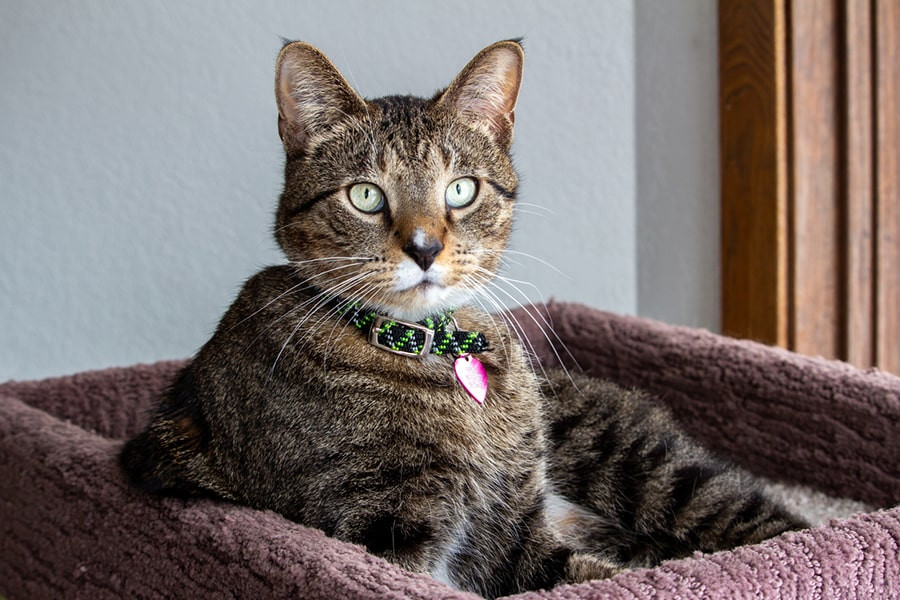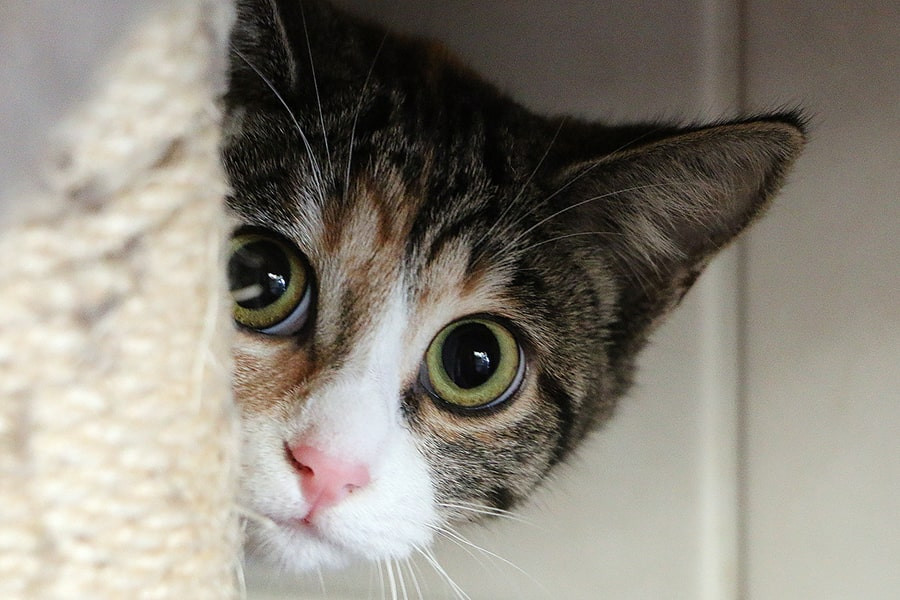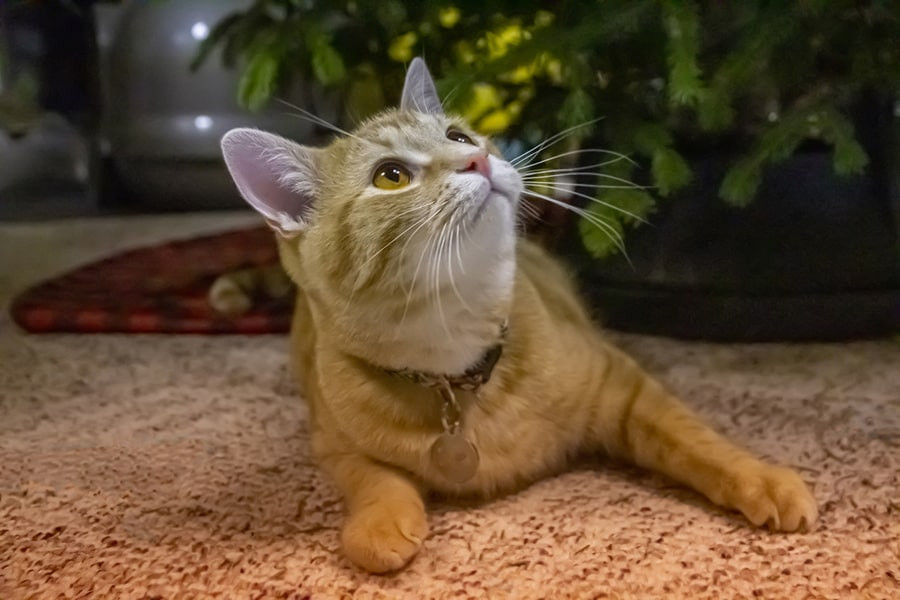Domestic Shorthair cats are arguably the most ubiquitous feline companions in homes across America, and for good reason. With an astounding population exceeding 80 million in American households, their popularity isn’t a mystery. These cats are widely celebrated for their amiable nature, minimal upkeep, and robust health, making them ideal pets for a variety of lifestyles.
 Gray tabby domestic shorthair cat relaxing comfortably in a maroon cat bed, showcasing its relaxed demeanor
Gray tabby domestic shorthair cat relaxing comfortably in a maroon cat bed, showcasing its relaxed demeanor
Understanding the Domestic Shorthair
The term “Domestic Shorthair” is more of a general descriptor than a breed designation. In essence, it refers to a cat of mixed ancestry with a short coat. Interestingly, in the United Kingdom, they are affectionately known as “moggies.” Think of them in the same vein as mixed-breed dogs; their genetic makeup is a diverse tapestry, resulting in a delightful range of appearances and characteristics. While some Domestic Shorthairs might bear a striking resemblance to specific purebred cats, this is purely coincidental and not indicative of shared lineage.
It’s crucial not to confuse Domestic Shorthairs with the American Shorthair. While these two types of cats may share similar robust builds and short coats, the American Shorthair is a distinct, recognized breed with a defined pedigree, setting it apart from the genetically diverse Domestic Shorthair.
Tracing the History of the Domestic Shorthair Cat Breed
Historical accounts suggest that the domestication of cats began in Egypt around 2000 B.C. These early domesticated felines are believed to have journeyed to the United States aboard the Mayflower. Their mission? To serve as natural pest control, safeguarding the ship’s stores from rodent infestations.
Domestic Shorthair cats quickly proved their worth to the Pilgrim settlers. Highly adept hunters, they were valued not only as pets but also as essential members of the farmstead, diligently controlling rodent populations in barns and homes. Over time, these original European cats evolved, eventually leading to the development of the American Shorthair breed we recognize today.
 Tabby domestic shorthair cat playfully peeking from behind a cat tree, highlighting their curious nature
Tabby domestic shorthair cat playfully peeking from behind a cat tree, highlighting their curious nature
The Popularity of Domestic Shorthair House Cats
Domestic Shorthairs have earned the endearing title of “house cats” due to their exceptional suitability as family pets. While they’ve also been referred to as “alley cats,” this term carries undeserved negative connotations. These labels might paint a picture of a generic feline, but the reality is far from it. Each Domestic Shorthair possesses a unique blend of physical attributes and personality traits, making them truly individual companions.
Exploring Domestic Shorthair Physical Traits
One of the most captivating aspects of Domestic Shorthair cats is their incredible diversity in coat color and pattern. While perhaps not found in every color imaginable, their coats span a vast spectrum including browns, tans, whites, blacks, reds, oranges, and countless shades in between. Furthermore, their coat patterns are just as varied, ranging from solid colors to bicolor, tricolor, tabby, and more.
Eye color in Domestic Shorthairs is equally enchanting. You might encounter eyes of blue, green, brown, hazel, or even captivatingly mismatched eyes, adding to their unique charm. In terms of size, the typical Domestic Shorthair cat weight can fluctuate significantly, generally falling between 6 to 16 pounds. Notably, male Domestic Shorthairs tend to be larger and heavier than their female counterparts.
Despite this remarkable diversity, certain physical characteristics are commonly observed in Domestic Shorthairs:
- Muscular and sturdy body build
- Rounded head shape and paws
- Medium length tail
Considering their robust nature, many prospective owners wonder: “How long do Domestic Shorthair cats live?” Fortunately, Domestic Shorthairs are known for their good health and relatively long lifespans. The typical Domestic Shorthair cat lifespan ranges from 12 to 14 years, and often even beyond. However, it’s important to remember that like all living beings, they are susceptible to unexpected injuries or illnesses and require consistent preventative veterinary care, including routine check-ups and vaccinations.
Unveiling Domestic Shorthair Personalities
Just as their appearances are diverse, so too are the personalities of Domestic Shorthair cats. Ask anyone who shares their home with a Domestic Shorthair, and you’re likely to hear a wide array of descriptions. They might be described as quiet and reserved, or perhaps quirky and playful. Some are known for their independence and strength, while others are sweet and affectionate, even clingy. You might encounter a daringly adventurous Domestic Shorthair, or one that’s sassy and clever. In truth, their personalities are multifaceted, often exhibiting a delightful mix of traits depending on their mood and the situation.
Essential Care for Your Domestic Shorthair
Another compelling reason for the popularity of Domestic Shorthair cats is their reputation as low-maintenance companions. They are naturally adept groomers, and their short to medium-length coats require minimal attention. While extensive grooming isn’t necessary, regular brushing remains beneficial. Brushing helps maintain their coat’s healthy condition and significantly reduces the occurrence of hairballs.
Upon welcoming a Domestic Shorthair cat into your home, it’s essential to schedule a veterinary visit promptly. If you’ve adopted a kitten, this visit should ideally occur within the first week. Consult with your veterinarian to establish a comprehensive care plan tailored to your cat’s needs. This plan should encompass proper nutrition, exercise guidelines, and a schedule for recommended wellness care, including vaccinations and parasite prevention. For further insights, resources like infographics detailing a kitty’s first veterinary visit can be invaluable.
An important aspect of responsible Domestic Shorthair ownership is keeping your cat indoors. Reputable organizations like the ASPCA strongly advocate for indoor living for cats. Indoors, cats are significantly safer from various hazards including traffic accidents, encounters with aggressive animals, parasites, and contagious diseases such as feline leukemia. Furthermore, Domestic Shorthairs possess natural hunting instincts. Keeping them indoors helps protect local bird populations and other wildlife, and also prevents unwanted “gifts” of prey being brought to your doorstep.
 Orange tabby domestic shorthair cat relaxing on a rug near a Christmas tree, showcasing their adaptability to indoor environments
Orange tabby domestic shorthair cat relaxing on a rug near a Christmas tree, showcasing their adaptability to indoor environments
Common Domestic Shorthair Health Concerns
Generally, Domestic Shorthair cats are considered a healthy breed. However, they can be predisposed to overeating, which can lead to obesity and a cascade of associated health issues. Overweight or obese cats are at increased risk of developing joint pain, back problems, liver and kidney disease, heart conditions, and diabetes.
To mitigate the risk of obesity, it’s vital to feed your Domestic Shorthair a balanced, high-quality diet and carefully measure portions to avoid overfeeding. Establishing a consistent feeding schedule, rather than allowing free-feeding, can also be beneficial. Be mindful of treats as well, as they can be calorie-dense and contribute to weight gain if given excessively.
Common Health Claims for Domestic Shorthairs
Like all cats, Domestic Shorthairs are susceptible to a range of ailments. Common health issues can include ear mites, skin disorders, upper respiratory infections, hyperthyroidism, kidney disease, and cancer. And despite their agility, they aren’t immune to accidents, sometimes misjudging jumps and falls.
Data from pet health insurance claims provides insights into the most frequently reported health issues for Domestic Shorthair cats:
- Vomiting
- Hyperthyroidism
- Gastrointestinal Issues
- Kidney Disease
- Diabetes
Pet insurance can be a valuable tool in managing the financial aspects of both unexpected illnesses and routine preventative care for your Domestic Shorthair. Unexpected events, like the need for surgery to remove ingested foreign objects, can be costly, highlighting the importance of financial preparedness for pet healthcare.
Adopting a Domestic Shorthair Cat
For those considering adding a feline companion to their family, it’s worth noting that Domestic Shorthair cats are frequently found in animal shelters, eagerly awaiting loving homes. Adopting from a local shelter is a wonderful way to provide a deserving cat with a second chance at a happy life.
Following adoption, spaying or neutering your Domestic Shorthair is a crucial step in responsible pet ownership. Beyond preventing unwanted litters, spaying and neutering offer significant health benefits, protecting against serious conditions like ovarian and testicular cancer.
To find a shelter in your area, resources like the ASPCA website can be invaluable. Additionally, familiarize yourself with the essentials of bringing home a new kitten, from the adoption process itself to fundamental kitten care practices, ensuring a smooth and joyful transition for both you and your new feline family member.
**Source: Internal Claims Data, 2015-20
Disclaimer: This article is intended for educational purposes only and should not be considered a substitute for professional veterinary advice. Always consult with your veterinarian for any health concerns or before making any decisions related to your pet’s health or treatment.
